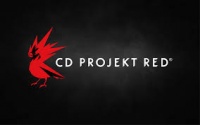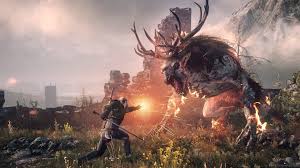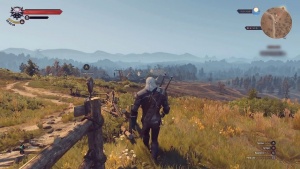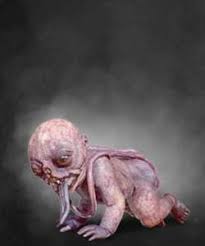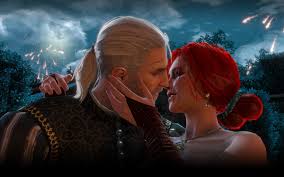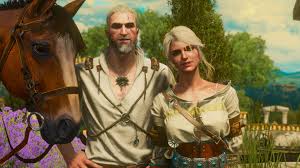Witcher 3: Wild Hunt
|
The Witcher 3: Wild Hunt is a third person action RPG video game created by polish company CD Projekt Red.[1] This game is third in the Witcher Series and was created to be the largest game in the series yet in terms of scope, story elements, and gameplay options. The Witcher 3 takes place in a fictional land called the Northern Kingdoms, which is designed to be similar in appearance and climate to that of Northern Europe and Scandanavia[2]. The game is an open-world adventure in which you take control of a master monster hunter by the name of Geralt of Rivia. The Witcher 3 includes sword fighting, the use of magic, horse riding, and even card playing as its main gameplay features.
In this fantasy environment, the player goes on an adventure as Geralt of Rivia to find and save the Emperor's daughter Ciri, who Geralt helped raise and train. A mysterious force called the Wild Hunt is after Ciri, and it is Geralt's job to save her from them.[3]
The Witcher series has come with success but Witcher 3 was the most successful game in the series by a large margin, trample both games that came before it with the Witcher 3 selling 15 times as much than its predecessor. With this contribution, the Witcher series reached a sale of 33 million copies in 2018[4], with a majority of those sales due to the Witcher 3's success.
Contents
Story
Act 1
The Witcher 3's story starts with Geralt trying to determine the location of Ciri, who has been missing for some time. In order to find Ciri, Geralt attempts to track down his old lover Yennefer[5], who is also a sorceress and could prove helpful in locating Ciri. After following Yennefer's track, but not being able to find her, and saving the town of White Orchard from a monster attack, the game's first act opens up into 3 different paths, each revolving around an area on the map. The first of these paths takes place in Velen, also known as No Man's Land. It is advised for the player to progress through this story path before moving onto either Novigrad or Skellige (where the other story paths take place) due to the different difficulties of enemies in these areas.
Whilst in Velen, Geralt attempts to extract information about Ciri through an agent and gets tied up with Philip Strenger, better known as the Bloody Baron by the people of Velen. In this questline, Geralt goes through a number of quests for the Bloody Baron surrounding the Baron's crippled life and family members with the promise that the Baron would give information on Ciri. Eventually, Geralt finds the Crones of Crookback Bog, which have ties with the Baron, and the Baron's wife even lives in the swamp with the Crones. At this point, the player is given the option to either kill a monster in a large tree or let it free, allowing it to destroy a nearby town. Regardless of your choice, the Crones provides Geralt with some information on Ciri, saying that she had been to the swamp, and afterward the Baron also gives Geralt information on his dealings with Ciri. From this point, the player is advised to move on to Novigrad.
In Novigrad, Geraly attempts to discern Ciri's exact location by trying to find another of his past lovers, Triss Merigold[5]. This questline entangles you with a powerful man in Novigrad, Reuven, who has many connections and possibly information on Ciri. After completing some quests for Reuven, he reveals that he doesn't have information on Ciri, but knows the location of an old friend of Geralt, named Dandelion. Dandelion apparently has seen Ciri recently, so Geraly goes off to save Dandelion from his current imprisonment, and is given more information on Ciri. Based on Dandelion's information, Geralt then heads to the Skellige Isles to continue his journey[6].
In Skellige, Geralt finally finds Yennefer and is close to Ciri's trail. In this questline, Geralt finds himself getting caught up in the local politics of the area and after helping Yennefer with enough quests, she gives him more information about Ciri, and about the Wild Hunt, who is the mysterious group of people hunting her. For the last mission in this area, which also happens to be the last mission in the first act, the game allows the player to play as Ciri, in a situation where she is fighting off members of the Wild Hunt and fleeing from them[6]. By this point, the enemy has been made clear to be the Wild Hunt and Geralt is hot on Ciri's trail. "A Frying Pan, Spick and Span" is a Side Quest in White Orchard, that sens the player toward the Nifgaardian Garrison, in order to discover an old woman shouting outside. She tells the player that she lent her frying pan to a stranger, and the stranger never returned it back to her, and that she is furious. The player is then tasked with finding the frying pan and returning it back to the woman. In order to do this, the player is meant to blast down the door to the house that the woman is shouting at. The way to do this is to use the Aard sign. Inside of the house, there is loot available to the player, in addition to collectibles that are able to be located using Witcher Sense. After collecting various items in the house, the pan is located in the back of the house. In addition to the loot rewards and collectibles, the player earns experience points and money, in addition to Baked Apples, and Apple Juice from the lady, after returning the frying pan back to her.
Act 2
Act 2 begins with Yennefer informing Geralt on her only lead to Ciri, which is a small deformed creature known as Uma. Yennefer believes that there is a curse on Uma and asks if Geralt would be willing to take Uma to the witcher school and home called Kaer Morhen. Geralt agrees and upon breaking the curse, he finds out that Uma is actually an elf named Avallac'h and was Ciri's traveling companion until recently. He reveals that he has been helping Ciri escape from the Wild Hunt, who is after her for her immense latent power. Avallac'h also explains that the Wild Hunt are hunters from a different realm that plan on using Ciri's power to invade more realms. Avallac'h also reveals that Ciri is in the Isle of Mists[5]. Geralt and the other witchers create a plan that they will bring Ciri back to Kaer Morhen in order to lure the Wild Hunt there for a battle. Before going to get Ciri, the player is advised to go and gather friends from across the lands to aid in the fight. After this, Geralt is off to the Isle of Mists to save Ciri and bring her back to Kaer Morhen. After retrieving Ciri and preparing for battle the Wild Hunt attacks. In the ensuing battle, Geralt and his forces are able to defeat a good portion of the Wild Hunt, but the leaders of the Hunt retreat, after killing Geralt's mentor and father figure, Vesemir, angering Geralt greatly. This act ends with Vesemir's funeral[5].
Act 3
Act 3 starts with Geralt and Ciri deciding to take the fight directly to the Wild Hunt. To do this, Geralt and Ciri go to the Bald Mountain, where they find they take two separate paths. Ciri takes the path that leads her to the Crones and she finds out they are evil and kills them. Geralt follows his path and finds the member of the Wild Hunt who killed Vesemir. Geralt defeats him and avenges Vesemir[5]. They then go out to find an artifact called the Sunstone, which is able to summon and bind the leader of the Wild Hunt to a specific location. After preparing for a final fight and finding the Sunstone, they are finally ready to end the threat of the Wild Hunt. Geralt and Ciri each kill generals in the Wild Hunt and eventually Geralt faces down with the leader of the Wild Hunt, Eredin, who he ends up defeating. During this time, Ciri goes off to face off against the White Frost, which is a magical energy that was being used by the Wild Hunt to end all life where ever they appeared and it is the strongest weapon. Ciri ends up destroying the White Frost. With their general and weapon destroyed, the threat of the Wild hunt is officially ended. There are many endings depending on the choices made throughout the game and can result in many fates for different characters, including whether or not Ciri survives the White Frost[5].
Secondary Quests
The game features hundreds of additional side quests that see Geralt helping people, looking for treasures, and fighting legendary monsters. These side quests are vast in variety and even have entire quest lines attached to side characters and secondary objectives. Some of these include large side quests such as an additional quest line for the Bloody Baron after he gives Geralt the information about Ciri and can be as simple as helping a woman find her frying pan[6]. In the Treasure Hunting sidequest: Deserter Gold, the player navigates Northeast to a river, in order to discover a dead body at an abandoned camp site. After clearing out potential attacks from Wolves and Wargs, the player is meant to inspect a container with a note from a spy, indicating the player to navigate to a building nearby. After finding the building located near a mill, and entering a house through the cellar, the player is rewarded with numerous treasure chests with loot. [7]
Gameplay
Geralt utilizes his swords as well as his unique abilities to defeat the monsters and enemies in the game. The range of movements available to the player includes running, jumping, walking rolls and different dodges. The protagonist, Geralt, utilizes a steel sword to battle human enemies and a silver sword for monsters. The player also has access to Geralt's magical abilities through five signs: Aard, Axii, Igni, Yrden and Quen, each with their own unique effects that can be upgraded. Being an open-world RPG, players are able to equip Geralt with new weapons and armor as the game progresses[8]. The open world format allows players to dictate how they want to progress in the story, and offers a wide variety of narrative side quests and objectives that serve to flesh out the fantasy setting and develop different characters. The game offers an average of 70-100 hours of total gameplay, although the developers have claimed that about a total of 200 hours exist if every piece of content is sought out and experienced. [9] Geralt gains experience with every mission completed and enemy slain, allowing him to grow in skill and strength as the game goes on. The progression of the player character is nuanced with a skill tree concept called "Mutagens". Mutagens are modifiers to the character's abilities or even unique abilities in and of themselves, allowing the player to build Geralt into their preferred playstyle. The entire game is only single player and is heavily narrative driven, so in most cases when talking to another character in the game, the player has the choice to decide what Geralt says. Choice is actually a prominent gameplay feature and decides how certain scenes will play out[8] and even effects the story, especially near the end of the game.
Netflix Show
The books and the game have inspired a Netflix show, which is set to be released in October 2019.[10] This live action series will star Henry Cavill as Geralt and production is happening in Hungary. To remain consistent with the books and game, the show is meant to take place in a snowy landscape. Other notable actors that will be in the show include Freya Allen as Ciri and Anya Chalotra as Yennifer. [11] Little is known about the plot of Season 1, however, Netflix released a short summary, stating: "Geralt of Rivia, a solitary monster hunter, struggles to find his place in a world where people often prove more wicked than beasts. But when destiny hurtles him toward a powerful sorceress, and a young princess with a dangerous secret, the three must learn to navigate the increasingly volatile Continent together."[12]
Public Reception
In addition to the afformentioned success of Witcher 3: Wild Hunt, in relation to its predecessors in the series, the game was widely praised and received a variety of awards[13]. Witcher 3 falls into the category of open world role playing games, and these open world RPGs are valued based on factors including graphical fidelity, which refers to the resolution, framerate, and overall visual appeal of the game itself. RPGs are also judged on their storyline, combat mechanics, quantity and depth of sidequests, and geographic size. With respect to these metrics, mainstream and alternative game reviewers alike praised the third installment of the Witcher series as being a high quality product. IGN gave the game a 9.3/10, citing its massive world, great characters, deep roleplaying, and responsive combat[14]. Games within the range of 9.0-9.9 are considered by IGN to fall into the category titled, "Amazing" [15]. Metacritic's registered critics gave it a 93/100, and Kotaku answered "yes" to the question they pose in their reviews: Should you play this game? [2]. Eurogamer called it "one of the best games of the generation"[16], Gamespot dubs it, "one of the best role-playing games ever crafted...10/10"[17], and Gameinformed said it, "encompasses what I hope is the standard for future RPGS...9.75/10"[17]. In addition, Witcher 3: Wild hunt was awarded "Game of the Year" by a variety of institutions, including, The Golden Joystick Awards, The Game Awards, Slant Magazine, Gamespot, Eurogamer, Wired, Official Xbox Magazine, Game Informer, and IGN, all in the year of the game's release, 2015. [13]
Ethical and Moral Dilemmas
Several storyline components raise questions on morality and choice, including how different characters are depicted by the game developers.
The Bloody Baron
"The Bloody Baron" is one of the most controversial questlines due to its depiction of gruesome and disturbing themes, serving as ethical representations of themes such as fatherhood. During the questline, it is revealed that the Bloody Baron is an alcoholic, and used to have a wife, which has not yet been seen in the game. It is later revealed that the Bloody Baron was meant to have a baby with his wife, but during a drunken rage he beat his wife and caused her to have a miscarriage. His baby becomes a monster called a botchling after the Baron simply threw out the remains of the stillborn child, rather than giving it a proper burial ritual. The botchling looks like a monstrous version of a baby, with the umbilical cord wrapped around the neck and incomplete facial features. The imagery of this monster and its presentation as an enemy was difficult for many players and touches on sensitive themes concerning the what is considered human life.
As the story progresses, the Bloody Baron appears to try his best to repent for his mistakes, eventually finding his wife in the Crookback Bog and apologizing to her. The players are not shown a one dimensional, evil man, but a multilayered person riddled with moral and ethical issues as he tries to repent for his prior sins. He is a man and a father who is given the chance not only to ask for forgiveness, but also given the opportunity to repent, as the botchling's soul can be saved if the Baron gives it a proper burial[18].
By giving the Baron this opportunity to properly bury his stillborn daughter and officially acknowledging her as his own, it gives the Baron an opportunity not only to repent for his sins, but also to confront who he is as a person. It allows the player to see a man who is in a sense an "anti-father"[18]finally take responsibility and become a real father for his child. The moral implication of this redemption is that sometimes prior mistakes can be dealt with and resolved on a personal level[18], but cannot be undone, as, after all, the Baron's child is still dead.
After his questline is resolved, the Baron has many different outcomes depending on player choices. One of these outcomes, is him hanging himself in the garden for the player to see. This act and the way that it is represented without being censored, caused more ethical issues, this time on the theme of suicide. This moment is meant to make players question the Bloody Baron's morality and whether mistakes can truly be resolved. Similar to how things that people post on the internet persist even if taken down, this situation is meant to make player wonder if their personal mistakes also persist despite our best attempts at solving them.[18][19] The moral and ethical issues of suicide and fatherism[18] are all highlighted and brought into question in the Baron's story.
Female Representation
The way that females have been represented in this game is not always appropriate and is somewhat sexist. Throughout the game, the player can simply walk into one of the many brothels located in the game and pay a relatively low amount of money to sleep with one of the women working there. In addition, most of the women that are part of the story can be romanced and slept with by Geralt, often dehumanizing otherwise deep female leads. Both the brothels and depiction of main female characters objectifies the females in the games without adding depth to the story, and their characters are used like tools that Geralt can use as he pleases without repercussions rather than dimensional people[20]. In addition to this, when Geralt and his selected woman are in the act, the scene shows them as stark opposites of each other, where Geralt's body is battle-scarred while the women all have perfectly clear bodies that all look somewhat similar, once again objectifying them and making them less of individuals and more like perfect playthings or toys[20].Some scholars have argued that even though video games that involve graphical depictions of sexual acts can be seen as pornographic, such virtual depictions are not morally wrong since no actual human beings are harmed in the process of generating such contents. [21]However, in Floridi and Sanders' argument, such contents are considered as a source of artificial evil due to their capability to negatively affect the nature and future developments of the recipients of such contents. [22] In the case of Witcher 3, by portraying women in this way, the game is negatively influencing male players, especially those who are in their teenage to adolescent years, to treat women as objects to be used rather than their equals.[20][23]. In a modern age where women are fighting to gain equality in treatment, the workplace and more, games such as this could prove to be a hindrance to such movements.
On the other hand, many people have seen the female presence in Witcher 3 as quite progressive. Many video games do not have any women featured in them, yet Witcher 3 does. Although the women are usually portrayed in a negative manner as addressed above, there are aspects of the video game that show women in a strong position. The Polish Studio, CD Projekt RED, that created Witcher 3 has made it a point to have women in the video game.
White Representation
In a world filled with a large multitude of monsters and unique characters, some players and critics found it very ethically concerning that almost every single character in the game is white. The lack of diversity in the lengthy RPG is concerning to some because it feels out of place and brings about some ethical questions as to why other races weren't included. The game does hail from Poland, which is known to be very proud of its heritage and ancestry, but this makes some wonder whether this is a valid excuse or even a reason to not include other races into the game.
The world is still filled with racism and people of color are continually looking for representation and different mediums to properly represent them[24]. One such medium is gaming, and we have seen an increase in games portraiting many different races and ethnicities as main characters. Games like the Last of Us, and Mortal Kombat are just a few titles that people of color can look to for representation[24]. Having the Witcher 3 be essentially whitewashed, is somewhat of a step back for people of color, as they could not find proper representation in such a critically acclaimed game as this.
Geralt's Character
Geralt's character is somewhat unique compared to other video game characters and is actually seen as a step forward for gender representation in video games[20]. Men in games in the past have been mostly linear characters who are very "manly" and are often seen defeating their enemies with little emotion. However, Geralt breaks this trope when compared to other protagonists. Although on the surface Geralt is a stone-cold murderer and monster hunter, the gave gives players some insight to his morality and softer side as they progress in the game, especially in relation to Ciri.
Many modern games have attempted to tackle parenthood in video games, such as The Last of Us and God of War, but Geralt's role as a father is unique in that he is not afraid in taking on a more feminine role in Ciri's parenting[20]. Unlike other father figures in gaming, who are often very strict and emotionless with their child figure, Geralt shows a very emotional and somewhat motherly like connection with Ciri, including having deep talks with her and even being playful enough to have snowball fights with the girl that he sees as a daughter[20]. This is important for ethics in gaming as it breaks the standard of strictly stoic men who have no emotions, and shows a deeper side to masculinity.Open World and Choices
The ability for the player to do what they want and interact with the open world in many ways is concerning on an ethical level. Players in this game are able to decide whether or not people die, push people towards suicide, or coerce them into doing their bidding. Players can haggle people, punish the rich and poor all alike, and refuse to help even the neediest of characters. On the other hand, players could help everyone they see and help everyone without taking pay. The choices made by the player in almost every part of this game are set up as moral dilemmas for players and even a reflection of the player's morality. Often time, choices within this game have both positives and negatives regardless of what a player chooses, resulting in some very difficult moral choices[25].
In a game where every choice matters, often times people want to make the best choices in order to receive the best outcome. However, The Witcher 3, doesn't always make this possible. Similar to the way things are in real life, CD Projekt Red implemented multi-faceted choices in order to show the players that not everything works out perfectly and that often times, choices have consequences[25]. Players are given difficult choices in order to not only test their morality but to also prepare them for choice making in their real lives. An example of this is when Geralt is given a choice whether or not to free a spirit. This spirit would free captive orphans if freed, but would also destroy a town. On the other hand, if the spirit is not freed, the orphans will continue to suffer[25]. Although players will never have choices like this in real life, the difficulty of choosing between two losing choices is very relevant to life and people's ability to choose morally[26].
Choice making is further amplified by the way that The Witcher 3 often breaks game theory, which is a player's knowledge of all the characters' ranges of actions and how their actions will affect the world[26]. The player is often thrust into situations where they do not know the outcomes of certain decisions and are even given certain time limits to make a choice, not only throwing the player into a somewhat realistic scenario where choices cannot be deliberated on for too long, but also testing their moral strength. Players are often times not given all the information they need to make a "correct" choice, and this is done intentionally in order to bring the importance of ethical and moral decision making to the players first hand[26].
References and External Links
- ↑ “The Industry Leader in Creating Role-Playing Games.” CD PROJEKT RED, en.cdprojektred.com/.
- ↑ 2.0 2.1 Hamilton, Kirk. “The Witcher 3: Wild Hunt: The Kotaku Review.” Kotaku, Kotaku, 31 Dec. 2015, kotaku.com/the-witcher-3-wild-hunt-the-kotaku-review-1703766283.
- ↑ “The Witcher 3: Wild Hunt.” The Witcher 3: Wild Hunt | Official Website, thewitcher.com/en/witcher3.
- ↑ Aernout. “Witcher Series Sells Over 33 Million Copies in 10 Years; Witcher 3 2017 PC Sales Equal PS4/XO Sales.” Wccftech, Wccftech, 23 Mar. 2018, wccftech.com/witcher-33-million-witcher-3-2017-pc/.
- ↑ 5.0 5.1 5.2 5.3 5.4 5.5 Hillier, Brenna. “The Witcher 3: Wild Hunt Guide and Walkthrough.” VG247, 20 Dec. 2017, www.vg247.com/2017/12/20/the-witcher-3-guide-walkthrough-pc-ps4-xbox-one-wild-hunt/.
- ↑ 6.0 6.1 6.2 “Walkthrough - The Witcher 3 Wiki Guide.” IGN, 13 Dec. 2017, www.ign.com/wikis/the-witcher-3-wild-hunt/Walkthrough.
- ↑ IGN, Witcher 3 Walkthrough: Deserter Gold, 2016, www.ign.com/wikis/the-witcher-3-wild-hunt/Side_Quests#White_Orchard_Side_Quests
- ↑ 8.0 8.1 Hamilton, Kirk. “A Beginner's Guide To The World Of The Witcher.” Kotaku, Kotaku, 3 Jan. 2018, kotaku.com/a-beginner-s-guide-to-the-world-of-the-witcher-1704506152.
- ↑ Tassi, P. (2015, May 18). 'The Witcher 3' And Game Length As A Mountain To Climb. Retrieved from https://www.forbes.com/sites/insertcoin/2015/05/18/the-witcher-3-and-game-length-as-a-mountain-to-climb/#18c619811aca
- ↑ Blake, Vikki and Roberts, Samuel The Witcher Netflix TV series: cast, release date and everything we know https://www.pcgamer.com/netflix-witcher-series/ Apr 17. 2019
- ↑ Watts, Steve. “The Witcher Netflix Series Releasing This Fall.” GameSpot, Gamespot, 23 Apr. 2019, www.gamespot.com/articles/the-witcher-netflix-series-releasing-this-fall/1100-6466325/.
- ↑ Schedeen, Jesse. “The Witcher Netflix TV Series: Everything We Know (Release Date, Cast, Plot and More).” IGN, IGN, 17 Apr. 2019, www.ign.com/articles/2019/04/17/netflixs-the-witcher-tv-series-everything-we-know-release-date-trailer-cast-plot-and-more.
- ↑ 13.0 13.1 “List of Accolades Received by The Witcher 3: Wild Hunt.” Wikipedia, Wikimedia Foundation, 13 Mar. 2019, en.wikipedia.org/wiki/List_of_accolades_received_by_The_Witcher_3:_Wild_Hunt.
- ↑ Ingenito, Vince. “The Witcher 3 Review.” IGN, IGN, 12 May 2015, www.ign.com/articles/2015/05/12/the-witcher-3-the-wild-hunt-review.
- ↑ “Review Scoring.” IGN Entertainment, corp.ign.com/review-practices/.
- ↑ Yin-Poole, Wesley. “Today Is the Third Anniversary of The Witcher 3.” Eurogamer.net, Eurogamer.net, 19 May 2018, www.eurogamer.net/articles/2018-05-19-today-is-the-third-anniversary-of-the-witcher-3.
- ↑ 17.0 17.1 Morris, Tatiana. “Review Roundup: Everyone Loves The Witcher 3: Wild Hunt.” GameZone, 12 May 2015, www.gamezone.com/news/review-roundup-everyone-loves-the-witcher-3-wild-hunt-3416403/.
- ↑ 18.0 18.1 18.2 18.3 18.4 Bertrand, Lucat. “Playing with Patriarchy: Fatherhood in BioShock: Infinite, The Last of Us, and The Witcher 3: Wild Hunt.” Digital Games Research Association, July 2017, www.digra.org/wp-content/uploads/digital-library/144_DIGRA2017_FP_Lucat_Playing_with_Patricarchy.pdf.
- ↑ Zagal, Jose P. “Ethical Reasoning and Reflection as Supported by Single-Player Videogames.” IGI Global, IGI Global, 1 Jan. 1970, www.igi-global.com/chapter/designing-games-ethics/50729.
- ↑ 20.0 20.1 20.2 20.3 20.4 20.5 Matuszek, Dawid. “The Witcher, or The End of Masculinity (as We Know It).” Kinephanos, July 2017, www.kinephanos.ca/2017/the-witcher-or-the-end-of-masculinity/.
- ↑ Patridge, Stephanie., 2013. "Pornography, ethics, and video games", Springer Science+Business Media Dordrecht, pg. 2-3
- ↑ Floridi, Luciano. Sanders, J.W., 2001. "Artificial evil and the foundation of computer ethics", Ethics and Information Technology, pg. 3-6
- ↑ Phelps, Edmund S. “The Statistical Theory of Racism and Sexism.” The American Economic Review, vol. 62, no. 4, 1972, pp. 659–661. JSTOR, www.jstor.org/stable/1806107.
- ↑ 24.0 24.1 MALKOWSKI, JENNIFER, and TREAANDREA M. RUSSWORM, editors. Gaming Representation: Race, Gender, and Sexuality in Video Games. Indiana University Press, 2017. JSTOR, www.jstor.org/stable/j.ctt2005rgq.
- ↑ 25.0 25.1 25.2 Tjahjono, Sam. “Pursuing the Other.” First Person Scholar, 26 Oct. 2016, www.firstpersonscholar.com/pursuing-the-other/.
- ↑ 26.0 26.1 26.2 Sashaerfanian. “An Ethical Witcher.” That's Not a Moon Game Reviews, 12 Aug. 2015, thatsnotamoonreviews.wordpress.com/2015/06/17/an-ethical-witcher/.
